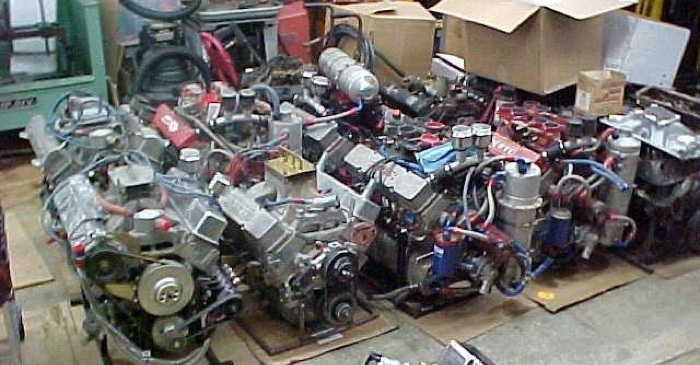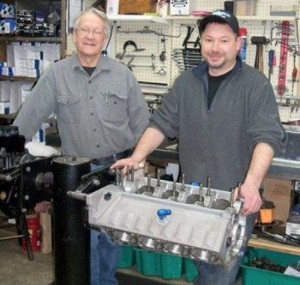
Different tracks work with different sanctioning bodies. Different sanctioning bodies have different engine rules. Different engine rules mean different opportunities to find new ways to beat the other guy to the checkered flag.
After all, winning is the ultimate goal of every racer and whether he or she ever attains that goal is often immaterial. For many grassroots stock and sprint car racers the quest for the checkers is prize in itself.
Since the majority of Engine Builder’s readers are involved to some degree with performance work, you understand that winning begets winning. You probablay also already know how important it is to go to the track.
To be successful in the performance market, you need to deliver a product or service that a competitor not only needs, but will help make him a winner. To find that product or service, you need to spend time with them to understand the needs of the racers. Find that need and put racers in the winner’s circle and you will have as much work as you can handle. It’s really pretty simple: making your customers successful will make you successful. That is as true in motorsports as it is in any other business endeavor.
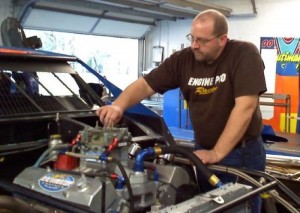
Wapokaneta, OH.
Understanding what “successful” means isn’t always easy, however. Does it mean building an engine that will win or simply one that will run consistently?
Making your customer successful means that you, or a trusted employee, often needs to spend time at the track with those customers – sometimes it’s as a consultant – other times it’s as a competitor.
Often, it’s just important that you are where they are, helping them when possible. This not only develops a good relationship, it also gives you the opportunity to determine additional needs, as well as find better ways of serving your customer.
We’ve said it in these pages before – it doesn’t matter if every driver at the track uses your products or services; you need to try and work with as many of them as possible, doing your best not to show any favoritism.
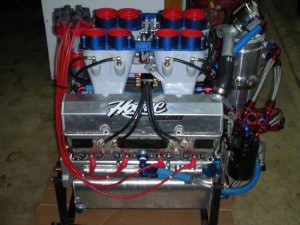
Your customer isn’t the only one you’re working with. Crew, family members and other competitors can be a great target audience. A little success can often lead to more success, until you are eventually seen as the guru for performance engine building.
As winter’s freeze begins to thaw in the Midwest, many engine builders are already in full swing in preparation for a racing season that is entirely weather-dependent. And one of the keys to helping racers have success on the track is understanding their needs off the track.
“Everybody’s hollering that their stuff isn’t done yet and they need it for this weekend, of course,” says Bruce Hogue, Hogue Racing Engine in Akron, IN. “Of course, they waited too long to bring it in to us!”
Hogue, one of Engine Builder’s finalists in the 2014 Performance Engine Builder of the Year contest sponsored by SpeedPro POWERFORGED Pistons, and his son Steven, discussed the upcoming racing season while attending to customer demands for a wide range of racing powerplants.
“We do a lot of UMP-style modifieds as well as non-wing 410 sprint cars racing in the BOSS Series out of Ohio,” says Hogue. “We also do some asphalt Street Stock Cars.”
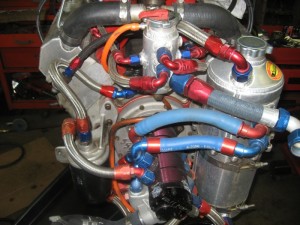
“There’s different style of racers, obviously – you’ve got your finessers and you’ve got your stabbers. So even though we’re trying to build a motor pretty well identical for everybody, there are changes that we need to make for them so they can actually hook it up like they want it because of their driving style.”
Kevin Frische, from Kalvinator Engines in Wapokoneta, OH, is also lucky enough to work with a variety of customers. “Locally we have three dirt tracks within 45 minutes of the shop so we do engines for the street stock class, UMP modified class and some 360 and 410 sprint car engines.”
Frische says the key is making sure customers at each of those levels are able to understand and communicate with you.
“You want to be the type of shop that people want to bring their engine to, even if they have to go out of their way to get there,” Frische explains. “Even if they have to drive past three or four other shops to get to yours, it’s often more important to be a good communicator, than the absolute finest engine guy.”
In other words, you need to be able to figure out what the customer wants even if he’s not sure – or able to tell you – what he wants himself.
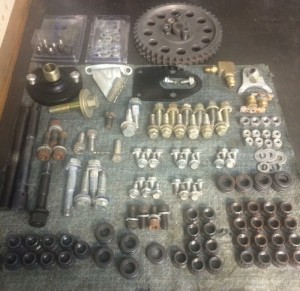
“There’s a lot of opportunity still out there (for racing work),” says Hogue. “It’s just finding somebody who is capable of doing it, basically. I mean, you have to have good quality machine work or you’re going to be out of luck, but it’s more important to be able to relate to their needs.”
Hogue and his son Steven put their money (literally) on the line and their reputation on the table each week as they compete alongside some of their customers. “We run locally at Gas City, Montpelier and Plymouth Speedways, which are all pretty close. I think that by actually racing ourselves and doing the engines too, we can relate to what our current and potential customers are trying to tell us.”
As with Tom Cruise’s “Cole Trickle” character in “Days of Thunder,” Hogue says that racers don’t always know how to express what they mean when it comes to a racecar setup.
“They may say there’s too much torque, they can’t hook it up on the bottom, they try to explain their gear ratios and stuff so we can relate to what they’re trying to tell us,” Hogue says. “So we might have to do a cam change to get them to where they want to be.”
Unlike many performance engine builders who suffer with the “Internet experts” who believe they know better about what components should be used for an engine, Hogue says his customers typically don’t question his judgment.
“Since I’ve been in it so many years, usually they don’t question what I do,” he explains. “They just walk in the door and say, ‘I need an UMP modified motor. What do you recommend I need to have?’”
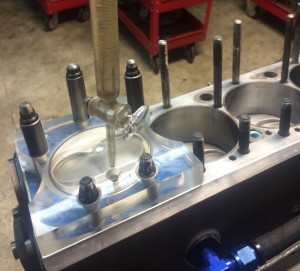
The Hogues have built their reputation for success by remaining loyal to their suppliers. “We’ve been loyal to 99 percent of all our manufacturers and once we find a good product, we pretty well recommend they stay with that,” says Bruce. “There have been times that guys have brought stuff into us and after checking it out we’ve just told them we would not use it because of fatality rates.”
And, yes, the customers listen. “I mean, when you’ve been in it this long, they understand you’ve been there,” says Steven. “Like I said, they know we’re not afraid to go to the racetrack and help them. A lot of nights, we’ll be racing personally and guys will have a problem – maybe it’s not even an engine that we’ve built – they’ll come over to us and ask for help on something. And I’ll say, ‘Well, you change my tire, I’ll be happy to work on your valves.’ And usually they’re happy to help us just as we help them.”
Kevin Frische also feels spending time at the track is critical. “We don’t compete against our customers at the track, though,” Frische says. “We go to the tracks offering tech support and also as a track vendor for the three dirt tracks.”
As stated earlier, defining “success” can be a tricky proposition. When you’re building engines for many different customers, many of whom compete against each other (and you!) at the same event, how much pressure is on building THE winning engine?
“I’d say with most of our customers, we’re lucky enough that they enjoy what they do. They’re not having to do it for a living,” says Steven Hogue. “What I mean is, when they buy one of our engines, they understand that it’s basically what somebody else’s got and the reason somebody else is winning is because they may spend a little bit more time in the garage working on it themselves. The majority – probably 80 percent – of our engines could be switched out of one guy’s car to another and the driver wouldn’t even notice a difference in the power ratio or anything.”

The combination of chassis, springs, shocks and engine are the secret sauce that the teams control, says Hogue. And often, that’s where the real secrets lie.
“They know that when they go to the track, the high dollar team probably does have a better engine and they might be behind the eight ball there. But they’re usually really cool about it. They understand that when you’re paying X amount of money and somebody else is paying twice that much, you probably won’t have quite the engine that other guy’s got.”
Which isn’t to imply that both the Hogues and Frische don’t put the same effort into building an engine their customers can depend on.
“Customers expect enough power to make every effort to win and reliable performance to last the racing season,” says Frische. “I’ll work with them to pair their budgets with what they need to be competitive. I can make recommendations to influence the engine build but sometimes they must adhere to their budget.”
Service Solutions
Steven Hogue says a key to maintaining customer satisfaction isn’t always about building a winner – it’s often just getting their engine back to them correctly.
“Whenever we get an engine in the door, whether we’ve built it or not, we always take a picture of it. Most of the time, we just end up with pictures of engines because most of the customers are great. Some of the time they may think we left something off the finished engine. It’s happened quite a few times that a guy says, ‘I know I brought my carburetor in with the engine,’ but when we look at the picture, he’s called back and says he found it on the shelf.
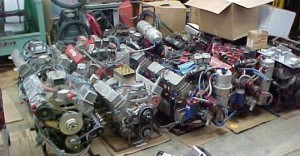 “They leave water pumps or belts or ignitions out of the motor and you know, once you’ve torn a race car apart you’ve got all these pieces laying around and engine parts around and don’t realize that they didn’t send this or that in.”
“They leave water pumps or belts or ignitions out of the motor and you know, once you’ve torn a race car apart you’ve got all these pieces laying around and engine parts around and don’t realize that they didn’t send this or that in.”
Hogue says one benefit is taking photos to help sort out wiring configurations, especially during reassembly. “Sometimes with the sprint cars, all the oil lines just look like a spaghetti factory, so photos help you know what went where and how they had it routed. That’s a huge time saver.”
Part of customer service is pushing preventive maintenance, says Bruce. “If a guy runs a motor in 10 nights and it starts smoking or something like that, the first thing we’ll tell him is to pull the air cleaner off – it’s likely he’s getting dirt in the carburetor. Almost all of them have that problem because they don’t have it sealed up as well as they should, the rings leave and then it’s time for a rebuild. This happens even though we tell them things to look for, how to maintain the engine, change the oil, cut the oil filters, look for debris, keep the temperatures down. It’s just common maintenance.”
Steven agrees that maintenance is critical. “Check the valves regularly because if you get a lifter starting to going bad or a broken valve spring, when you get the rocker arm off or the valve cover off you can see that issue.”
For the Hogues, maintenance is second nature, so they share that with their customers. “Those things just come natural to us so we try to relate to our customers with things they may not understand,” says Bruce.
For Kevin Frische, too, customer communication is critical to understanding their concerns – spoken and unspoken. Think about what your shop can add to help keep your customers racing into Victory Lane – and back to your shop.

